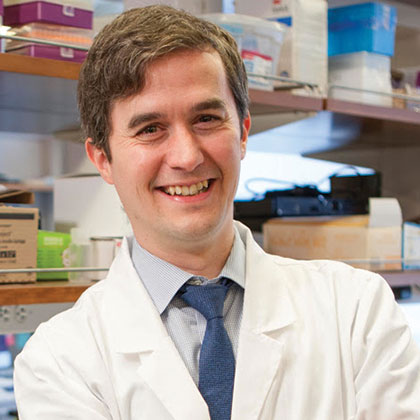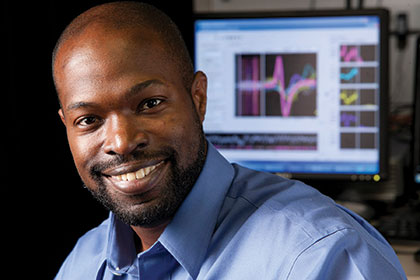2021 Research Report
Scientists at Hope for Depression Research Foundation Are Assembling a Picture of How Depression Develops in the Brain, Leading to New Treatments
Clinical depression is the world’s single leading cause of disability, ahead of heart disease and cancer. It is a devastating illness that shatters lives. And yet science does not have a firm understanding of it or new ways to treat it. Conventional medications like Prozac (or other SSRIs) are over 35 years old and do not fully work for 50% of patients.
The Hope for Depression Research Foundation (HDRF) is working to change that with advanced research. Many have heard that depression is caused by a “chemical imbalance” in the brain, something to do with a serotonin deficiency. This explanation is not inaccurate, but it is too simplistic to lead to new treatments.
In fact, the most important underlying cause of depression lies elsewhere. It involves our stress response; when our brain’s fight or flight circuits get stuck in the “on” position for so long that it becomes toxic. Cells and circuits are thrown off balance, affecting sleep, memory, mood and behavior.
“Depression affects a large swath of the brain,” said acclaimed brain scientist Dr. Huda Akil, PhD, who works with HDRF. “The entire biochemical and cellular balance of many brain areas is altered.”
Our stress response involves hundreds of molecules and hormones that influence the brain and change it. Some stress is good for us, but an extended or chronic stress response can leave what might be viewed as “scars” in the brain that initiate the pathology of depression. But how? And when?
This is where the HDRF Depression Task Force comes in. This team of nine world-acclaimed neuroscientists are from different universities but have joined forces in a historic effort under the auspices of the Hope for Depression Research Foundation.
The Depression Task Force (DTF) is starting to discover more about these “scars” left by stress in the brain, and also the genetic variations that make some of us more vulnerable to stress than others. This is leading to new ideas for treatment; HDRF has one clinical trial underway currently at Columbia and Mount Sinai (see below), and others in the pipeline.
No other team has been able to achieve the Depression Task Force’s integrated approach. Their labs collaborate seamlessly and share unpublished data to accelerate discovery. Working together, the HDRF researchers can embrace the complexity of the brain, from genes to molecules to cells and entire circuit networks. They can also step back to see how risk pathways develop during the life course, from infancy to old age.
“While we are working on understanding the genetics and brain biology of mood disorder and on finding better treatments,” said Dr. Akil, “the real goal is to prevent the illness and stem the epidemic of depression.”
“Their leadership will influence the field for the next 50 years and beyond,” said Dr. Nestler, current Chair of the DTF and head of the Friedman Institute at Mount Sinai.
DEPRESSION TASK FORCE RESEARCH PROJECTS
While the progress outlined below is described separately for each scientist, in reality every member of the Task Force is involved directly in everyone else’s endeavors.

- A CLINICAL TRIAL FOR A POTENTIAL NEW CATEGORY OF MEDICATION IS UNDERWAY
Dr. Jonathan Javitch, a psychiatrist and biochemist at Columbia University, has identified a very specific pain receptor that malfunctions in patients with severe depression, which may blunt the ability to cope with the psychosocial stress of rejection in relationships (ie. losing a job or promotion, ending a relationship). This has led to the trial of a compound that can fix the receptors through targeted action. The compound, known as tianeptine, represents a brand new category of antidepressant. Clinical trials began October 2020 at Columbia University and Mount Sinai Medical Center.

- NEW GENES DISCOVERED THAT UNDERLIE TEMPERAMENT AND RESILIENCE TO STRESS
Dr. Huda Akil, a neurogeneticist at the University of Michigan, is concerned with how the temperament we are born with impacts our stress reactivity. Recently, she has discovered a critical new gene family that underlies differences in temperament, which in turn can make an individual exquisitely sensitive to stress, or resilient to stress. Her lab has discovered these emotionality genes in laboratory animals, and they are currently bridging these findings to humans.

- RESEARCH IN EUROPE SHOWS HOW STRESS IMPACTS CELLS IN THE FETAL BRAIN
Dr. Elisabeth Binder, a neurogeneticist and epigeneticist at Germany’s renowned Max Planck Institute, is a leader in the genetic basis of depression, with a particular focus on the body’s stress system. Her research shows that when prenatal brain cells are exposed to the stress hormone cortisol, many genes are altered that can increase the risk of depressive outcomes later in life. This process is strongly rooted in very small genetic variations, and our goal is match specific variations with specific effects on cell behavior. In the future, we want to be able to predict, by taking our genetic sequence at birth, whether we are at risk for developing major depression and apply the appropriate preventive measures based on that read-out.

- IMPACT OF ADVERSE CHILDHOOD EXPERIENCE IS DIFFERENT IN MEN AND WOMEN
Dr. Michael Meaney, a neurogeneticist and epigeneticist at McGill University in Canada, shows how stressors in the environment contribute to depression by causing “epigenetic” changes”– ones that turn genes on or off without altering the genes themselves. His work reveals how adversity early in life can permanently change the expression of key genes, and, as a result, increase the risk of developing depression in adulthood. Most recently, Meaney is studying how early life adversity affects men and women differently and creates different pathways of risk during a sensitive period of brain development. Understanding these mechanisms can help us develop precise early prevention strategies.

- THE GENETIC BASIS OF RISK AND RESILIENCE THROUGHOUT LIFE
Dr. Eric Nestler, a molecular psychiatrist and neurobiologist at Mount Sinai, uses sophisticated mouse models of depression and post mortem brain tissue from depressed humans to map how stress produces lifelong chemical changes in key mood areas of the brain. Many of the changes are negative, causing hyper-reactivity to stress and risk for illness. Other changes, however, are positive and generate natural resilience to stress. This fascinates us, because we know that many cures and preventions for depression lie within our own bodies. They are just waiting to be discovered. Recently, this work has identified a potential new treatment to promote resilience which we will test in pilot clinical trials this year.

- NEW FINDINGS MAY UNLOCK NEW TREATMENTS FOR DISORDERS LIKE PTSD THAT ARE ASSOCIATED WITH DISTRESSING MEMORIES
Dr. Rene Hen, a neuropharmacologist at Columbia University, is an expert in the hippocampus – a brain area that supports memory, mood and emotion. He has discovered specific nerve cells in the hippocampus that work carefully to code our experiences as good or bad, rewarding or fearful. In anxiety-related disorders like PTSD, memory coding goes awry, which can result in recurring distressing memories that come up completely out of context. Hen’s work points to ways we can diagnose broken memory circuits and intervene to treat them.

- STUDIES IN PRE-FRONTAL BRAIN CIRCUITS SHOW NEW SUB-TYPES OF DEPRESSION AND DIFFERENCES IN MEN AND WOMEN
Dr. Conor Liston, a psychiatrist and neuroscientist at Weill Cornell Medicine, uses advanced neuroimaging techniques to study circuits in the pre-frontal cortex, a brain area that controls memory and regulates behavior. This part of the brain is heavily implicated in mood and anxiety disorders. His work in the past year shows that the pre-frontal cortex exerts its influence by maintaining a reserve of good memories that can be activated to elicit reward-seeking behavior. Liston has identified several circuit abnormalities that point to different subtypes of depression, which can now be used to target precision treatments to these subtypes. He has also identified distinct patterns of abnormal connectivity in men and women.

- MAPPING BRAIN-WIDE CIRCUITS THAT UNDERLIE EMOTIONAL PROCESSING
Dr. Kafui Dzirasa, a neurobiologist and biomedical engineer at Duke University, is studying the role of entire brain circuits in mood and mood disorders. Dzirasa maps circuits by measuring brain waves – the electrical activity of cells and circuits. This approach allows us to see how different brain regions communicate and coordinate with one another to give rise to distinct emotional states such as motivation, anxiety, aggression, and the desire to engage socially with others. When the communication between brain regions is abnormal, this can foretell risk for depression. Dzirasa’s important discoveries point the way to a new class of precision diagnostics for depression based on large-scale measures of electricity in the brain.

- REFINING KNOWLEDGE OF HUMAN NEURAL CIRCUITS IMPLICATED IN DEPRESSION
Dr. Helen Mayberg, a neurologist at Mount Sinai, is a pioneer in Deep Brain Simulation (DBS) to treat severe, resistant depression. In DBS, a pair of electrodes is implanted in a precise area of the brain and connected by wires to a pair of pulsing devices in the chest (akin to a cardiac pacemaker). The electrodes emit a kind of jamming signal to circuits in the brain known to be involved in depression, while leaving other circuits intact. Mayberg’s groundbreaking work allows the Depression Task Force to better understand how all of the circuits of the brain connect and interact. As more clear and precise circuit knowledge emerges from the group, Mayberg is in turn able to refine the areas she targets with DBS treatment.
